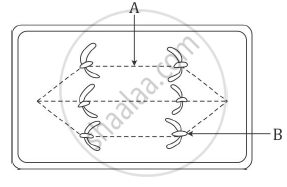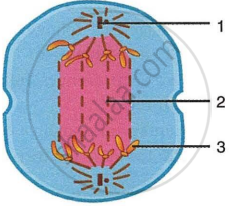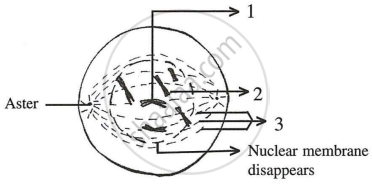Advertisements
Advertisements
Question
The diagram given below represents a certain stage of mitosis:

- Identify the stage of cell division.
- Name the parts labelled A and B.
- What is the unique feature observed in this stage?
- How many daughter cells are formed from this type of cell division?
Solution
- Anaphase
- A - Spindle fibre, B - Centromere
- During this stage (anaphase), the two sister chromatids of each chromosome separate and are drawn towards the opposite poles because of the shortening of spindle fibres.
- This type of cell division (mitosis) results in the formation of two daughter cells.
APPEARS IN
RELATED QUESTIONS
The diagram below represents a stage during cell division. Study the same and then answer the questions that follow:

- Name the parts labelled 1, 2, and 3.
- Identify the above stage and give a reason to support your answer.
- Mention where in the body this type of cell division occurs.
- Name the stage prior to this stage and draw a diagram to represent the same.
Given below is a diagram representing a stage during mitotic cell division in an animal cell Examine it carefully and answer the questions which follow.

- Identify the stage. Give one reason in support of your answer.
- Name the cell organelle that forms the ‘aster’.
- Name the parts labelled 1, 2 and 3.
- Name the stage that follows the one shown above; how is that stage identified?
- Mention two differences between mitosis and meiosis with regards to:
- The number of daughter cells produced.
- The chromosome number in the daughter cells.
With the help of suitable diagrams, explain the five stages of prophase-I of meiosis.
Define the following:
Karyokinesis
Draw a well-labelled diagram to show the anaphase stage of mitosis in plant cells having four chromosomes.
Complete the following sentence with appropriate word :
______means the splitting of the nucleus.
The karyotype (set of chromosomes) shown below is taken from a dividing cell in a certain individual.
(i) Is the individual male or female? Explain your answer.
(ii) How would you expect
(a) a female cell and
(b) sperm cell to differ in chromosome composition?
In which stage of mitosis the chromosomes align in an equatorial plate? How?
